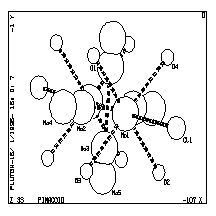D0006
ON THE HEAVY ATOM QUANTUM INTERFERENCE SCATTERING PHENOMENA IN
DIMOLYBDENUM(ll) DIMERS. Boris Udovic, Primoz Segedin, Faculty of
Chemistry and Chemical Technology, University of Ljubljana, P.O. Box 537, 61001
Ljubljana, Slovenija
 Pyramidally coordinated oxygen atoms freeze and hinder the librational motions
of quadruple bonded dimolybdenum(II) dimers inside the prismatic cage of
zwitterionic 3,5-diaminobenzoate tetracarboxylate units. De Broglie wavelength
[[lambda]]Mo~1.44 Å and [[lambda]]Mo~2.10 Å
were computed from vibrational spectra at 293 K and assigned to low energy
components of the superimposed and periodic motions of molybdenum atoms along
the principal dimer axis. The expected quantum interference fringe maxima of
interdiffusing and scattering lMo waves were confirmed in the
Fourier difference maps with observed electron density anomalies on the
alternative axes inside and outside the oxygen cage at 293 K. The quantum
singularities were refined at the wavelength distances
[[lambda]]Mo(2) = 1.4904(11) Å, [[lambda]]Mo(3) =
1.4901(13) Å, [[lambda]]Mo(4) = 2.09(5)Å,
[[lambda]]Mo(5) = 2.08(5)Å, from the vibrating molybdenum
atoms Mo(1) and Mo(1)(iii) in their potential wells. The occupancy factors of
the alternative sites Mo(2) and Mo(3) inside the cage were 3.8% and 4.2%, while
outside the cage the alternative sites Mo(4) and Mo(5) were 0.31% and 0.25%
respectively. In the prismatic cage the heavy atom random thermal energy, with
its related statistical temperature, is converted into a directed kinetic
energy with different velocity components which are linked to a rather
localized and oriented low temperature by frozen vibrational motions of very
cold metal atoms trapped in their quantum well.
Pyramidally coordinated oxygen atoms freeze and hinder the librational motions
of quadruple bonded dimolybdenum(II) dimers inside the prismatic cage of
zwitterionic 3,5-diaminobenzoate tetracarboxylate units. De Broglie wavelength
[[lambda]]Mo~1.44 Å and [[lambda]]Mo~2.10 Å
were computed from vibrational spectra at 293 K and assigned to low energy
components of the superimposed and periodic motions of molybdenum atoms along
the principal dimer axis. The expected quantum interference fringe maxima of
interdiffusing and scattering lMo waves were confirmed in the
Fourier difference maps with observed electron density anomalies on the
alternative axes inside and outside the oxygen cage at 293 K. The quantum
singularities were refined at the wavelength distances
[[lambda]]Mo(2) = 1.4904(11) Å, [[lambda]]Mo(3) =
1.4901(13) Å, [[lambda]]Mo(4) = 2.09(5)Å,
[[lambda]]Mo(5) = 2.08(5)Å, from the vibrating molybdenum
atoms Mo(1) and Mo(1)(iii) in their potential wells. The occupancy factors of
the alternative sites Mo(2) and Mo(3) inside the cage were 3.8% and 4.2%, while
outside the cage the alternative sites Mo(4) and Mo(5) were 0.31% and 0.25%
respectively. In the prismatic cage the heavy atom random thermal energy, with
its related statistical temperature, is converted into a directed kinetic
energy with different velocity components which are linked to a rather
localized and oriented low temperature by frozen vibrational motions of very
cold metal atoms trapped in their quantum well.
 Pyramidally coordinated oxygen atoms freeze and hinder the librational motions
of quadruple bonded dimolybdenum(II) dimers inside the prismatic cage of
zwitterionic 3,5-diaminobenzoate tetracarboxylate units. De Broglie wavelength
[[lambda]]Mo~1.44 Å and [[lambda]]Mo~2.10 Å
were computed from vibrational spectra at 293 K and assigned to low energy
components of the superimposed and periodic motions of molybdenum atoms along
the principal dimer axis. The expected quantum interference fringe maxima of
interdiffusing and scattering lMo waves were confirmed in the
Fourier difference maps with observed electron density anomalies on the
alternative axes inside and outside the oxygen cage at 293 K. The quantum
singularities were refined at the wavelength distances
[[lambda]]Mo(2) = 1.4904(11) Å, [[lambda]]Mo(3) =
1.4901(13) Å, [[lambda]]Mo(4) = 2.09(5)Å,
[[lambda]]Mo(5) = 2.08(5)Å, from the vibrating molybdenum
atoms Mo(1) and Mo(1)(iii) in their potential wells. The occupancy factors of
the alternative sites Mo(2) and Mo(3) inside the cage were 3.8% and 4.2%, while
outside the cage the alternative sites Mo(4) and Mo(5) were 0.31% and 0.25%
respectively. In the prismatic cage the heavy atom random thermal energy, with
its related statistical temperature, is converted into a directed kinetic
energy with different velocity components which are linked to a rather
localized and oriented low temperature by frozen vibrational motions of very
cold metal atoms trapped in their quantum well.
Pyramidally coordinated oxygen atoms freeze and hinder the librational motions
of quadruple bonded dimolybdenum(II) dimers inside the prismatic cage of
zwitterionic 3,5-diaminobenzoate tetracarboxylate units. De Broglie wavelength
[[lambda]]Mo~1.44 Å and [[lambda]]Mo~2.10 Å
were computed from vibrational spectra at 293 K and assigned to low energy
components of the superimposed and periodic motions of molybdenum atoms along
the principal dimer axis. The expected quantum interference fringe maxima of
interdiffusing and scattering lMo waves were confirmed in the
Fourier difference maps with observed electron density anomalies on the
alternative axes inside and outside the oxygen cage at 293 K. The quantum
singularities were refined at the wavelength distances
[[lambda]]Mo(2) = 1.4904(11) Å, [[lambda]]Mo(3) =
1.4901(13) Å, [[lambda]]Mo(4) = 2.09(5)Å,
[[lambda]]Mo(5) = 2.08(5)Å, from the vibrating molybdenum
atoms Mo(1) and Mo(1)(iii) in their potential wells. The occupancy factors of
the alternative sites Mo(2) and Mo(3) inside the cage were 3.8% and 4.2%, while
outside the cage the alternative sites Mo(4) and Mo(5) were 0.31% and 0.25%
respectively. In the prismatic cage the heavy atom random thermal energy, with
its related statistical temperature, is converted into a directed kinetic
energy with different velocity components which are linked to a rather
localized and oriented low temperature by frozen vibrational motions of very
cold metal atoms trapped in their quantum well.